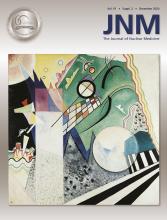History is the unfolding of miscalculation.
—Barbara W. Tuchman, American historian
In celebrating 60 years of JNM, it is hard to conceive of molecular imaging without 18F-FDG PET, particularly in oncology. Recognizing the importance of metabolic reprogramming in malignant transformation, seminal studies demonstrated the utility of 18F-FDG PET for detecting cancer and assessing response to therapy. Even using a single field of view, preliminary studies on breast cancer, for example, demonstrated the prognostic value of a reduction in 18F-FDG uptake and the ability of PET to predict benefit earlier and better than conventional imaging (1). Whole-body imaging subsequently allowed global assessment of cancer distribution before and after therapeutic intervention. No molecular imaging, radiology, or oncology meeting these days is not replete with serial maximum-intensity-projection images demonstrating therapeutic efficacy.
Despite widespread acceptance of the power of 18F-FDG PET to diagnose and follow cancer clinically, its adoption and regulatory recognition as a response assessment tool in clinical trials are still limited compared with anatomic imaging as codified in RECIST. Recognition that adoption of 18F-FDG PET as a surrogate biomarker of survival depends on validated and reproducible definitions of response led the European Organization for Research and Treatment of Cancer to develop therapeutic response guidelines (2). Competing with this attempt, scoring systems based on semiqualitative assessment of 18F-FDG PET after treatment were developed and implemented, such as in lymphoma (3). The Achilles’ heel of qualitative and quantitative systems is observer variation and lack of consistent, standardized measurements, which also account for technologic innovations, respectively.
A landmark advance in efforts to harmonize response assessment using 18F-FDG PET was the publication of PERCIST (4). These guidelines not only integrated knowledge of the reproducibility of 18F-FDG uptake measurements but also defined methodologies for selection of target lesions. Although measurement of up to 5 lesions is recommended, PERCIST defines response on the basis of changed uptake in the single most intense lesion on the baseline and posttreatment scans, even when this lesion is not the same lesion. As well as having the attraction of simplicity, PERCIST is conceptually appealing in that the final outcome might be best defined by the least responsive disease. Since then, PERCIST has been gradually setting the standard to assess metabolic response, but additional schemes also evolved, addressing perceived limitations of relying on measurement of only lesional uptake, which is subject to variation related to methodologic factors (5). Similarly, one could argue that it is not sensible to have a single threshold for both partial metabolic response and progressive disease that ignores the type of therapy, timing of assessment, and kind of tumor.
As the therapeutic armamentarium has expanded, so too have the mechanisms and temporal profiles of metabolic response. Targeted therapies are recognized to have qualitatively and temporally different responses from those of chemotherapy, with abrogation of pathway signaling sometimes having an early and profound impact on glycolytic metabolism not mirrored by morphologic regression (6). Response to immunotherapy poses its own challenges, with patterns of response including pseudoprogression and very slow regression. These have led to several adaptations to response criteria, variably incorporating follow-up confirmation of response and correlation with clinical and anatomic imaging findings.
Although PERCIST has done much to strengthen the place of 18F-FDG PET in response assessment within clinical trials of novel therapeutics, its authors would likely agree that there is a wealth of information that could be leveraged both for predicting and for monitoring response, particularly in guiding management of individual patients. Combining lesion intensity and tumor burden integrated with radiomics and genomic data may provide better predictive prognostic tools than any of the methods currently in play. This improvement, however, would require that PET methodology be standardized to allow metaanalyses to reach the levels of evidence necessary for clinical implementation. If we stubbornly persist with simplistic analysis tools, we will miss the opportunity to advance our field and benefit our patients.
DISCLOSURE
Rodney Hicks holds shares in and is a scientific advisor to Telix Pharmaceuticals, with all proceeds donated to his institution. No other potential conflict of interest relevant to this article was reported.
- © 2020 by the Society of Nuclear Medicine and Molecular Imaging.
REFERENCES
- Received for publication May 29, 2020.
- Accepted for publication June 11, 2020.







